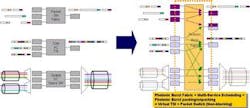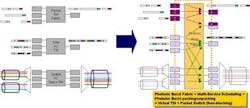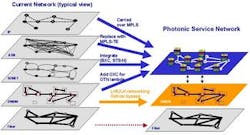Return to profitability with photonic service switching
By DENNY LEE
AcceLight Networks
With the recent economic downturn in the telecommunication sector, service providers and network architects are focusing on one fundamental business question: How does one evolve the network to return to sustained profitability? Ultimately, the "network" is a business tool that enables communication services, which, in turn, generates profit for the service providers. This holds true regardless of the scope of service spectrum and the operating footprint of the network operator. Despite the current economic conditions, there is still genuine traffic growth from the subscriber base for both packet-based and circuit-based services. This is evidenced in reports such as [1-3]. One must ensure that the network--and the underlying investment--is optimally utilized for revenue-generating purposes. This involves minimizing one-time and recurring capital expenditures (capex) and operational expenditures (opex) and maximizing existing and future revenue-carrying services.
Photonic Service Switching fulfills this mandate for the optical networking area. To ensure the return to profitability, any networking solution must have the following fundamental attributes:
• An evolutionary approach that supports existing services and enables future services.
• Network simplification--Network equipment consolidation and network architecture simplicity are key elements for minimizing capex outlay.
• Operation simplification--Consolidation of the physical network must be accompanied by streamlined network management operation.
• Scalability--ensure linear cost growth in accordance to traffic demands
• Carrier class solution--Service resiliency and survivability are essential to subscriber retention and new customer generation ability.
Photonic service switching is designed and guided by these principles.
Network element consolidation
WDM technology deployment over the last five years has provided network operators with a baseline infrastructure of networked wavelengths. This infrastructure delivers a scalable platform for transmitting information between traffic demand locations. Service providers are focused on utilizing this baseline transmission infrastructure to maximize profit-generation.
The switching network elements that attach to this transmission infrastructure are associated with a wide range of technologies and formats, e.g. packet, frame, time slots, wavelengths, etc. The practice of deploying separate network elements for each of these technologies is a major contributor to Point of Presence (POP) complexity and capex. The need to interoperate and manage this diverse set of network elements increases opex to very high levels and limits the ability to adapt to changes in service demand.
A photonic service switch--a new switching element that can support multiple services--is a key step in achieving network consolidation. Such a network element can simultaneously address existing capex and opex issues while providing flexibility in accommodating changes in service demand. The key to a photonic service switch is a scalable fabric that simultaneously supports packet, circuit, and time slot switching. This major improvement presents the opportunity to deliver a protocol transparent fabric for a multiservice environment that supports Internet Protocol (IP) packet, Multi-Protocol Label Switching (MPLS) labels, ATM virtual circuits, SONET/SDH, and wavelength service line cards. This key advance in technology enables multi-terabit/second fabric, while reducing common equipment costs and operation simplification.
Photonic service networking
These key ingredients of photonic service switching provide the basis to flexibly groom, switch, and multiplex statistical (bursty) packet traffic as well as deterministic circuit traffic such as STS-N TDM circuit or continuous wavelength circuit. Appropriate optical-electrical-optical (OEO)-based line cards can be deployed to provide physical interfacing, performance management, packet header processing, TDM timeslot processing, and traffic management functions. These data path functions are complemented by the Generalized MPLS (GMPLS) control plane, which provides the multi-hierarchical management of flows across the network.
The service-capable line cards in conjunction with the unique multi-service switching nature of fast fabric switching forms a new class of network element called Photonic Service Switch (PSS). An interconnection of PSS network elements is termed Photonic Service Network. Although the underlying technology of PSS is revolutionary, the resulting network solution must be grounded in guiding principles as outlined above. As such, the PSS is designed as an evolutionary network element focused on achieving the ultimate business objectives. Using the overlay architecture typically found in the backbone network, Figure 2 illustrates the consolidation vision of the photonic service network. This includes a physical network simplification process that converges complicated existing overlay structure into two main network layers--one focuses on scalable transmission of information based on DWDM technology, while another focuses on service-optimized switching of traffic onto the transmission infrastructure using the photonic service network solution. Much of the same attributes highlighted below are equally valid in metro-core context.
Functional attributes of the photonic service networking solution are listed below:
• "Packet + Circuit" aggregation efficiency--Much of the photonic service networking strategy is rooted on the basis of providing legacy services as well as emerging services. Clearly, "legacy" circuit-based SONET/SDH private line services such as DS-1, DS-3 (and OC-3) are stable components of the revenue stream. This, in turn, has driven a renewed recognition of STS-1 grooming at the core-edge of the transmission network. On the other hand, the main traffic growth component remains data traffic driven. Continuous innovation in Internet-based applications such as gaming, media-streaming, and distributed computation has fueled the continuous demands on network capacity. Service providers must recognize these growth agents and leverage them into profit-generating opportunities. An efficient packet-networking infrastructure is therefore an essential ingredient.
• Network Optimization--Also essential are the abilities to optimally use the network resource based on traffic demands.
• Network Engineering--To complement the network optimization capability, a set of traffic engineering and Quality of Service (QoS) mechanisms gives network operators maximum flexibility and controllability to plan and maintain their networks. These include the ability to direct traffic flows, control the utilization level of links, and offer relative as well as absolute QoS for emerging packet services.
• Ring-to-Mesh migration--The photonic service networking solution provides network operators with a realistic and evolutionary mechanism to transform their network from a typical cascade and stack-ring structure to a mesh-based topology. Many industry literatures have illustrated the benefits of mesh in minimizing route-miles consumption given a set of traffic demands. The IP-rooted GMPLS control plane enables such migration.
• Streamlined Operation with GMPLS control plane--Recognizing that opex is the significant component of service providers cost base [4], a photonic service networking solution delivers a streamlined network management operation that includes an intelligent and highly automated network and service turn up process for all switching services. A recent empirical study reveals a 70% improvement in opex outlay for service provisioning when compared to a traditional overlay network model [5].
Network optimization and economic implication
The service flexibility of the photonic service network solution has strong economic implications to network operators. It is intuitively obvious that a simplified network naturally leads to a simplified network management processes, hence lowering the recurring opex cost. Subtler is the notion of network optimization to minimize capex outlay using the "packet + circuit" nature of the photonic service network solution. It is important to recognize that efficient usage of network resources, such as delaying turn-up of new wavelengths and delaying deployment of new line cards on switching network elements also proportionally minimizes the recurring opex cost.
The service flexibility nature of photonic service networking allows information between two demand locations to be most optimally switched and transported given the existing network constraints such as fiber topology, fiber usage, link bandwidth utilization, peering topology, and, of course, the underlying traffic demand characteristics.
Recent studies [6-7] of wide-area Internet traffic characteristics by lead researchers in the field have confirmed that internet data traffic can be benefited by providing statistical multiplexing at the core-edge of the network. This is, statistical gain can be achieved by strategically performing statistical multiplexing in selected locations in the network.
Clearly, packet traffic between two demand locations can be switched and transported using statistical multiplexing techniques (i.e. fine grain flows), TDM circuits, or direct wavelength connectivity, while circuit traffic is switched and transported by TDM or wavelength circuits. If one considers the capital cost of satisfying this traffic demand, the cost base contains two main components: switching equipment cost and the transmission cost. Transmission cost is independent of the service multiplexing technique (i.e. a bit is a bit regardless if that bit is in a TDM timeslot or packet). Transmission cost is, however, dependent on the physical constraints such as fiber type and its characteristics, route distance, DWDM technology, etc. On the other hand, switching equipment cost is dependent on the underlying traffic demand characteristics (e.g. burstiness of data traffic), network topology, route computation, and service multiplexing techniques at each switching point (e.g. IP connectionless forwarding, MPLS connection-oriented forwarding, TDM grooming, wavelength switching, etc.). Using cost-based routing and traffic engineering capability of the GMPLS control plane, the photonic service network provides network operators the ability to achieve service delivery optimization, thus minimize their capex and opex outlay.
Denny Lee is the director of product management at AcceLight Networks (Ottawa, Ontario). He may be reached via the company's Web site at www.accelight.com.
References


